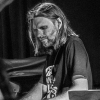Home » Jazz Articles » Album Review » Ron Stabinsky: Free for One
Ron Stabinsky: Free for One
Music is emotional sound and is extremely hard to adequately describe except in the most broad manner. Unpremeditated improvisation is especially difficult to put into words, all the more so when the improvisation is not on something (see Jean-Michel Pilc's What Is This Thing Called?), and when the player is comfortable in that place between jazz and modern classical music.
In Charles Evans's wonderful On Beauty Stabinsky turned out to be the glue holding together and enhancing Evans' music. Stabinsky's path to reach this point has taken over a decade of hard work, relentless introspection and self-honesty. Perhaps the most important question is whether the player himself disappears; the bottom line for all music is whether it communicates to and involves the listener. Is he or she moved to tears, to dance, to stop everything and just listen?
Although Free For One is less "romantic" (overall) than Paul Bley's Solo In Mondsee, it is comparable in the cohesiveness of the set, the audible logic of the improvisational development and most importantly in the emotional communication of the performance.
While this music was recorded in one day, most probably the pieces were not recorded in the order presented, especially since (Charles) Evans is given credit for "layout and track selection." Opening with ..."After It's Over" is interesting in that this listener kept hearing very oblique references to Charles Mingus's "Goodbye Pork Pie Hat". That "Once, But Again," with its much "jazzier" feel harmonically and rhythmically (but never actually "swinging") ends the set is also telling.
In between are improvisations of varying character that explore different ideas in ways that can be followed, at least after multiple listens. It is not that Stabinsky can be heard thinking, but rather that the manner in which the music evolves becomes understandable; of course, it is Stabinsky, and not someone else, that is playing, but also in a very real sense the music is simply unfolding and flowing out of him.
Stabinsky's music has enormous emotional depth which, however, might take some time to be appreciated by those who have not come to creative improvised music from the classical side. That said, it is quite worth the time to listen repeatedly to Free For One and be won over by Stabinsky's mind and his music.
Track Listing
...After It's Over; 31; Viral Infection; Gone Song; For Reel; Not Long Now/Long Now; Rapture; Once, But Again.
Personnel
Ron Stabinsky
pianoRon Stabinsky: piano.
Album information
Title: Free for One | Year Released: 2016 | Record Label: Hot Cup Records
< Previous
Reciprocity
Next >
Steam In The Casa
Comments
Tags
Ron Stabinsky
CD/LP/Track Review
Budd Kopman
Braithwaite & Katz Communications
Hot Cup Records
Jean-Michel Pilc
Charles Evans
Paul Bley
Charles Mingus
Free for One
For the Love of Jazz
 All About Jazz has been a pillar of jazz since 1995, championing it as an art form and, more importantly, supporting the musicians who create it. Our enduring commitment has made "AAJ" one of the most culturally important websites of its kind, read by hundreds of thousands of fans, musicians and industry figures every month.
All About Jazz has been a pillar of jazz since 1995, championing it as an art form and, more importantly, supporting the musicians who create it. Our enduring commitment has made "AAJ" one of the most culturally important websites of its kind, read by hundreds of thousands of fans, musicians and industry figures every month.




















